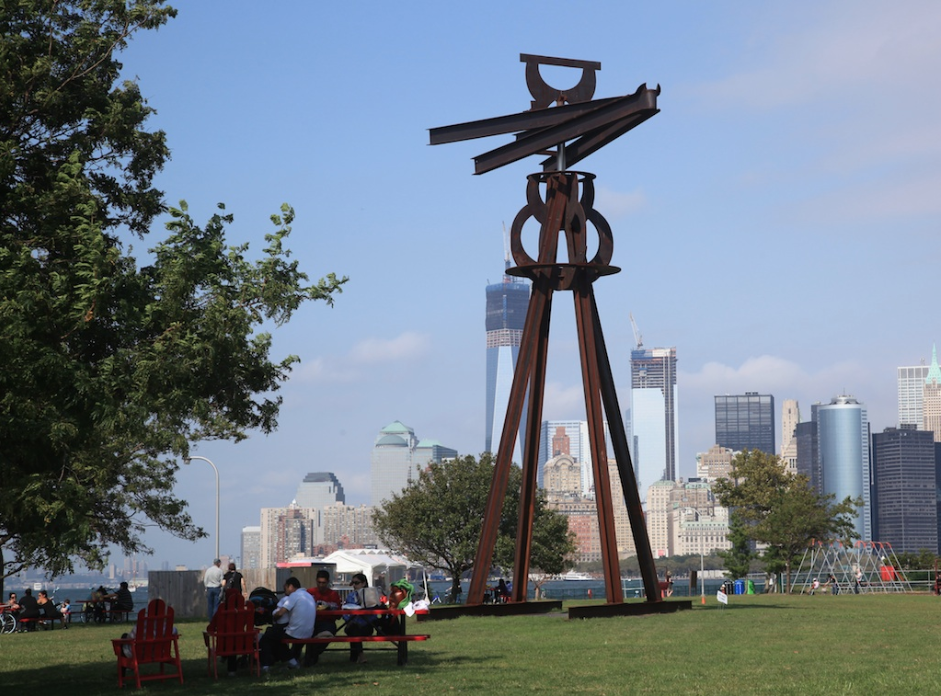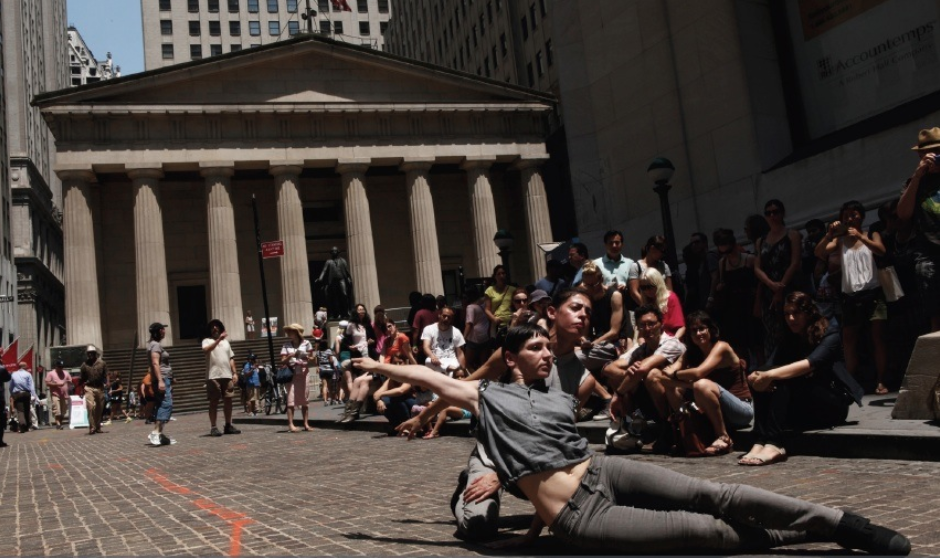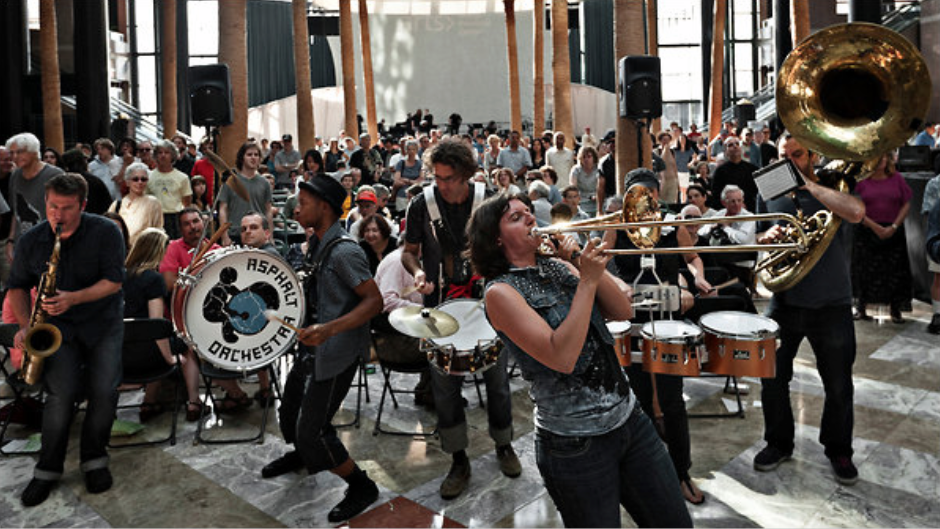Success Looks Different Now: Design and Cultural Vitality in Lower Manhattan is the product of an inquiry by the Architectural League, instigated by an idea of the cultural journalist Paula Deitz for a new cultural center on New York’s waterfront. Outlined below are the conclusions of the study, as well as recommendations for responding to the evolving conditions of the arts, community, and climate change.
This study addresses several questions that were prompted by a proposal for an architecturally dynamic performing arts center on New York Harbor. How can architecture and urban design best support cultural vitality in Lower Manhattan? Would an iconic new performing arts center make a significant contribution to the ongoing rebuilding and reimagining of the district? If not, what types of design interventions and investments would help build cultural vitality in Lower Manhattan? What would make Lower Manhattan the multidimensional, mixed-use area that it aspires to be? And how can culture thrive on a site, and in a neighborhood, that is vulnerable to storms like Sandy?
Observations and Analysis. Paula Deitz’s suggestion to build a performing arts center on New York Harbor captures some of the spirit of the new culture of the arts that is manifesting itself in New York and other vibrant cities around the globe. Her proposal would combine the functions of a performing arts center and a civic auditorium, join new architecture with an existing historic building, and house space for the visual arts as well as social space that is active far beyond performance times. However, a number of factors indicate that a freestanding waterfront performing arts center, aspiring to be an icon of New York’s cultural sophistication and reach, may not be the priority it once seemed. Several factors indicate that there may be better ways to expand and intensify cultural vitality in Lower Manhattan:
- Decentralized Culture at the Waterfront Activation of the Lower Manhattan and nearby waterfronts is happening without the catalyst of a singular performing arts or other cultural facility; the activity that is animating downtown’s edges is diverse and multicentered.
- Iconic Public Space Well-designed, heavily used public space is already both symbol and embodiment of New York’s cultural vibrancy.
- Expanding Cultural Landscape In New York, a number of innovative projects that both represent contemporary thinking about cultural programming and connect to the public realm in dynamic ways are being developed, from the proposed hybrid spaces of Pier 57 on the Hudson River to the proposed cultural venue on the upper floors of Pier 17 at the South Street Seaport.
- National Trends The decline in audiences for traditional place-based performance, the potential decline in philanthropic and government funding for the arts, and the potentially burdensome carrying costs of capital projects, suggest that new building projects for the arts be undertaken only with a compelling and plausible programmatic vision.
These factors should not be read to suggest that the revitalization of public and cultural space in Lower Manhattan has happened purely organically or without the intentional involvement of many actors and a great deal of financial investment, public and private, but simply that the long-accepted model of iconic building as catalyst now seems out of date, or in need of reinvention, to be responsive to the evolving conditions of the arts, community, and climate change.
SHOWN by MArisa Hassabi at Broad and Wall Streets, presented by LMCC as part of the River to River Festival 2012 | photo: Julieta Cervantes, courtesy Lower Manhattan Cultural Council. All Rights Reserved.
Recommendations This inquiry aims to stimulate a renewed dialogue about ways to foster and support cultural vitality in Lower Manhattan through architecture and urban design as they reflect a contemporary response to arts policy and programming. Observation and analysis suggest that there must be a balanced approach to supporting cultural production, presentation, and experience:
Respond to the Changing Environment for Innovation and the Arts
- To become better known as a place for innovation in the arts, Lower Manhattan should visibly and explicitly support the creation and presentation of new work. The city should prioritize the capacity of institutions to afford and use space—existing and new, permanent and temporary, interior and exterior—for cultural production and presentation. With respect to design, implement strategies that suggest ways for multiple institutions to share facilities and costs, such as the creative and opportunistic reinvention of existing spaces, as well as thinking about time itself as a resource.
- Apply the lessons of demonstration projects and find inspiration in other creative initiatives, from the mussel beds at Pier 35 and the storm-water management at Brooklyn Bridge Park to the bold ideas such as those presented in MoMA’s Rising Currents—all while taking a broad-scale approach to Lower Manhattan’s vulnerability to flooding. There is a need for a full range of incremental steps, many of which have implications for how the buildings and public spaces of Lower Manhattan operate regardless of whether it is ultimately possible to marshal all of the resources needed to make the infrastructure improvements called for in the city’s June 2013 resiliency plan.
Continue to Invest in Public Space that Supports the Arts
- To ensure design excellence in the public realm, dedicate resources to the analysis of what is working best and why in New York’s current public space with regard to both the conventional definition of the arts and broader definitions of culture. The city has invested hundreds of millions of dollars in its public realm, and it should study the results closely.
- Continue to invest in outdoor productions, a cultural enterprise that has become associated with Lower Manhattan; provide the tools for effective installations and performances, from programming to permits to temporary, mobile equipment and services.
- Support exterior spaces that offer the scale and freedom necessary for temporary cultural performances and exhibitions. Support ad hoc and opportunistic endeavors in spaces that are both adaptable and intentionally unfinished.
Align a Performing Arts Center at the World Trade Center with a Vision for Lower Manhattan as a Creative Center
While the leadership of the proposed performing arts center at the World Trade Center is seeking to address both the opportunities and challenges it faces, the city should rigorously assess plans for the project to ensure that it meets several important goals: engages contemporary artistic production within its walls and beyond them with a full menu of formal and informal cultural activities; overcomes security and location limitations to connect with the life of the city; provides both artistic vision and flexible, creative programming; supports artists who live and work in the area; and presents work relevant to diverse local and international audiences.
Advocate for Cultural Vitality at a Time of Political Transition
As New York heads into an election season and selects a new mayor, there is an opportunity to clearly assert the role of cultural vitality and the design of the public realm in the final push to complete the post-9/11 rebuilding of Lower Manhattan. In combination with field observation, data collection, testing, and analysis, this renewed conversation should start with a series of structured discussions and background papers leading to final recommendations. Those fueling the “expressive life” in New York—from leading artistic producers and educators to community leaders and designers—need to have a direct dialogue with the new generation of public and private funders about the purpose and potential of arts-related projects in Lower Manhattan and on nearby waterfronts.
Brooklyn Hip Hop Festival 2010 in Brooklyn Bridge Park. | photo: Robert Adam Mayer at the Brooklyn Hip Hop Festival. All Rights Reserved.
Conclusion
Architecture, landscape architecture, and urban design can and are shaping environments that accommodate and stimulate artistic expression and participation in New York and elsewhere. However, the economic realities of the present moment are sobering, and they need to be acknowledged, analyzed, and responded to with a smart mixture of caution, ambition, and optimism. The current moment calls for carefully calibrating investments in facilities for the arts, so as not to overwhelm organizations with fixed costs that impair their capacity to carry out their missions and to present their work to a wide range of audiences.
The need for calibrating those investments is occurring at a time when it is clear that the emerging audience for the arts does not require the glistening halls of an earlier generation to engage in cultural experiences. The Lower Manhattan waterfront may still have iconic sites and programs that merit bold architectural expression, but the impetus has changed–the waterfront is already activated. It is already a destination, especially as an arena for new kinds of arts experiences.
In 2010, architecture and cultural critic Cathleen McGuigan wrote that “The phenomenon of using iconic architecture to promote a city, an institution, or a real-estate development was a product of the economic boom that . . . ended with the recession in 2008.” She goes on to note that architects who win commissions for major cultural projects now “are likely to propose schemes that are sensitive to their urban habitat.” While the slate of new cultural institutions underway around the world suggests that McGuigan may have spoken too soon about the demise of iconic architecture, her larger point remains relevant, as many aspirationally iconic projects now seek connections to their urban habitat, both existing and envisioned.
New York is a place where being sensitive to the urban habitat, including its cultural ecology, can yield remarkable rewards. Its greatest cultural identity has always been connected to its public space. In the past decade, city policy and practice have demonstrated an increasing respect for and sensitivity to this precious asset. The city has also recognized that its public realm is not a fixed, historic entity, but a dynamic proposition—one that will continue changing with the push and pull of deliberate programs and unanticipated events.
Asphault Orchestra playing in the 2011 Bang on a Can Marathon at Battery Park City, presented by LMCC, Arts Brookfield and Bang on a Can as part of the River to River Festival. | photo: Stephanie Berger, courtesy Bang on a Can. All Rights Reserved.
Lower Manhattan, the core of New York City for almost four centuries, remains a work in progress. Since the middle of the 20th century, it has been compelled to change by events ranging from the rise of containerized shipping to the destruction of the World Trade Center towers and the rising waters of Sandy. Effectively one of the largest building sites in the world today, Lower Manhattan is once again remaking itself.
There is no perfect formula for the arts’ role in this reinvention, but the arts can provide an opportunity for Lower Manhattan to develop an identity as a place of innovation. For inspiration, it may be useful to look away from the cultural facilities of an earlier generation and toward initiatives that exemplify connections between the knowledge economy, the arts, and community—such as the new BRIC Arts/Media/Urban Glass project opening this year in the retrofitted Strand Theater in Downtown Brooklyn. Lower Manhattan isn’t Brooklyn, but, despite its greater cost and density, its success as a multidimensional place calls for an investment in culture that is as “downtown” as it is in the borough across the East River.
This study began by assessing the viability of a new performing arts center on the Lower Manhattan waterfront—a design that could stand up to the iconic site of the city on the harbor and change the “postcard” of New York. Based on the analysis of interviews, research, and site visits, it is clear that a single edifice can no longer exemplify New York’s culture of the arts; the city can no longer be symbolized by one image. To accurately reflect today’s dynamic and multicentered culture of the arts requires not one postcard but a set of them: a performance-art dinner on Governors Island, a film screening at Brooklyn Bridge Park, a theatrical performance in Battery Park City, and a participatory dance event on the East River Esplanade. Success looks different now.
Success Looks Different Now: Design and Cultural Vitality in Lower Manhattan is a publication of The Architectural League of New York. All Rights Reserved. The report was made possible with public funds from the National Endowment for the Arts. Additional support was provided by the J. Clawson Mills Fund of the Architectural League of New York. To inquire about obtaining a copy of the complete report, email info@archleague.org




